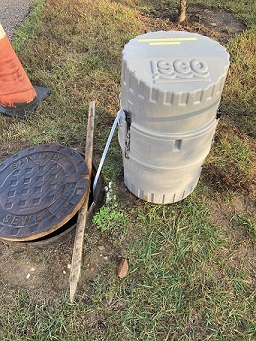Page last updated on September 7, 2021 at 11:17 am
For more information, please contact
James Hall - Assistant Director of Environmental Programs, Utilities Department, [email protected], 812-349-3657
The Challenge
There is MUCH we don’t know about COVID-19. Unfortunately, tests can take 3-4 days to return results and by that time, a person may have been sharing the virus with many others. COVID-19 is an RNA virus; while it is highly unlikely it be transmitted through wastewater, it does survive in wastewater and its evidence can be measured there. Wastewater plants run on bugs; they need nutrients to get rid of waste. However, illicit drugs or toxic materials can have a negative impact on Monroe Wastewater Plant’s ability to treat water if such substances make it through the system in high quantities. In the past, City of Bloomington Utilities (CBU) has worked with the Bloomington Police Department to track down illegal dumping or trace instances of drugs in wastewater runoff to mitigate these risks of improper water treatment. The same strategies and tools can be applied to tracing the COVID-19 virus. “Scientists believe humans begin shedding the virus RNA up to five days before average symptom onset. Most individuals do not seek testing until symptoms are present, which can be between five and 14 days after initial exposure. After testing, results may not be available for two to 14 days. This greatly delays the ability of municipalities, communal living facilities and colleges to contain the spread of the virus” (120 Water). Therefore, CBU wanted to look at its wastewater to get a sense of how much virus was present in the system. However, the initial challenges to do so were significant. Though CBU had used auto samplers before to trace illegal dumping and narrow in on an offending industry or company, tracing COVID requires more data, and therefore more time, equipment, and money to fund the data collection. CBU needed increased resources to collect enough data to begin making inferences about its meaning.
The Idea
Sewer lines drain to particular points throughout the city and starting in July 2020 CBU tasked its crews with collecting wastewater samples three times per week at these points both manually and using automated samplers. The idea was to use the data collected as a predictor of where there might be a COVID outbreak. Given that wastewater could signal COVID shedding 5 days before people become symptomatic, wastewater samples showing higher than normal rates of COVID could be helpful to alert officials about a possible outbreak and the need to quarantine and/or the possibility of increased hospitalizations from a particular zone. CBU’s engineering division used GIS to create a dashboard to present this data along with an interactive map so staff can narrow down areas with higher concentrations of the virus around town. Then, the data must be sent off to labs for testing and analyzed for meaning.
The Cost
Initially, CBU staff were limited in the number of locations around the city they could test three times per week for COVID presence. It took three separate people four hours per person to go around to the different sites and either collect water out of the autosamplers (which collect data over 24 hours to create a composite sample) or do a grab sample manually (which essentially takes a snapshot in time of the water and whatever it contains). When conducting grab samples, to get accurate data, they had to go at the exact same time of day to each site. Though CBU owned some autosamplers before this COVID project, they did not have enough to meet the needs of this project. It cost $5000 for a new autosampler and $1500 to fix any older or broken ones. These costs caused a significant strain on the Wastewater Plant team. Luckily, CBU did not have to carry the burden of these costs alone for very long. 120water, a digital water company, is now funding the project and has enabled CBU staff to collect samples at as many locations as they can. See https://120water.com/120water-launches-solution-for-early-detection-of-covid-19-using-wastewater-testing/ to learn more about 120 Water’s innovations and partnerships with other cities besides Bloomington. With the help of 120water CBU was able to purchase two additional autosamplers and fix two others that were broken. Now the remaining significant cost involves lab testing. Each sample costs approximately $200 per sample for external labs to process. The Indiana Finance Authority for the State of Indiana is totally funding the cost associated with testing the samples so Bloomington does not have to do so.

The Benefit
The benefit to testing wastewater for COVID is that you can see the virus present in the wastewater about one week before you see an outbreak in symptoms. If we know where to trace COVID back to, or if we can see an influx in its presence in one particular area, CBU might be able to warn hospitals and medical professionals about an upcoming uptick in cases. In general, testing allows CBU to effectively measure the concentration of the virus coming from particular places around town, which can impact recommendations made to the Mayor’s Office for related action and effective distribution of resources. Looking ahead to the era beyond COVID, this same kind of wastewater testing could be used to test for other viruses, trace opioid use, or assist law enforcement in other drug-related cases.
Metadata
City Department(s): City of Bloomington Utilities Environmental and Engineering Divisions
City Point(s) of Contact: James Hall, Assistant Director of Environmental Programs
Partner(s): 120 Water, Indiana Finance Authority
Partner(s) Point(s) of Contact: N/A
Type of Innovation: Technical/Data Analysis, Public Health
Date Implemented: July 2020
